Compatibility Assessment in the Replacement of Damaged Sandstone Used in the Cathedral of Huesca (Spain)
Abstract
1. Introduction
1.1. Ebro Valley Natural Stone: Miocene Sandstone in the Cathedral of Huesca
1.2. Stone Decay in the Cathedral of Huesca
1.3. Aim of the Study: An Assessment for the Restoration Programme
2. Materials and Methods
3. Results and Discussion
3.1. Petrographic Characterization and Colour of the Evaluated Sandstones
3.2. Hydric and Related Parameters
3.3. Selection of the Replacement Sandstone
3.3.1. Microporosity
3.3.2. Accelerated Ageing Cycles
3.4. In Situ Water-Repellent Test
3.5. Laboratory Tests to Evaluate the Hydrophobic Effect
3.5.1. Colour Changes
3.5.2. Hydric and Related Parameters
4. Conclusions
Author Contributions
Funding
Data Availability Statement
Acknowledgments
Conflicts of Interest
References
- Cuchí, J.A.; Lapuente, P. Canteras antiguas de arenisca del entorno de la ciudad de Huesca. Lucas Mallada 2016, 18, 85–128. [Google Scholar]
- Lapuente Mercadal, M.P.; Auqué Sanz, L.F. Respuesta de diversos tratamientos de conservación en la arenisca del Real Monasterio de Santa María de Sijena, Huesca. Geogaceta 2003, 34, 75–78. [Google Scholar]
- Smith, B.J.; Gomez-Heras, M.; McCabe, S. Understanding the decay of stone-built cultural heritage. Prog. Phys. Geogr. Earth Environ. 2008, 32, 439–461. [Google Scholar] [CrossRef]
- Doehne, E.; Price, C.A. Stone Conservation. An Overview of Current Research, 2nd ed.; Getty Conservation Institute: Los Angeles, CA, USA, 2010. [Google Scholar]
- Alonso, F.J.; Ordaz, J.; Esbert, R.M. Indicators of deterioration in stone building materials. Classification and analysis of damage. In Coremans Project: «Criteria for Working in Stone Materials»; Laborde Marqueze, A. (Coord.) Ministerio de Educación, Cultura y Deporte. Secretaría General Técnica; Subdirección General de Documentación y Publicaciones: Madrid, Spain, 2013. [Google Scholar]
- Camuffo, D. Microclimate for Cultural Heritage: Measurement, Risk Assessment, Conservation, Restoration, and Maintenance of Indoor and Outdoor Monuments; Elsevier: Amsterdam, The Netherlands, 2019. [Google Scholar]
- Amoroso, G.G.; Fassina, V. Stone Decay and Conservation: Atmospheric Pollution, Cleaning, Consolidation and Protection; Elsevier: Amsterdam, The Netherlands, 1983. [Google Scholar]
- Price, C.A. Stone Conservation: An Overview of Current Research; Getty Conservation Institute: Los Angeles, CA, USA, 1996. [Google Scholar]
- Elert, K.; Rodriguez-Navarro, C. Degradation and conservation of clay-containing stone: A review. Constr. Build. Mater. 2022, 330, 127226. [Google Scholar] [CrossRef]
- Sancho, C.; Fort, R.; Belmonte, A. Weathering rates of historic sandstones structures in semiarid environments (Ebro Basin, NE Spain). Catena 2003, 53, 53–64. [Google Scholar] [CrossRef]
- Winkler, E.M. Stone in Architecture: Properties, Durability, 3rd ed.; Springer: Berlin/Heidelberg, Germany, 2007. [Google Scholar] [CrossRef]
- Siegesmund, S.; Snethlage, R. (Eds.) Stone in Architecture; Springer: Berlin/Heidelberg, Germany, 2011. [Google Scholar]
- Brantley, S.L.; Kubicki, J.D.; White, A.F. (Eds.) Kinetics of Water-Rock Interaction; Springer: New York, NY, USA, 2008. [Google Scholar]
- Warscheid, T.; Braams, J. Biodeterioration of stone: A review. Int. Biodeterior. Biodegrad. 2000, 46, 343–368. [Google Scholar] [CrossRef]
- Gadd, G.M. Geomicrobiology of the built environment. Nat. Microbiol. 2017, 2, 16275. [Google Scholar] [CrossRef] [PubMed]
- Potysz, A.; Bartz, W. Bioweathering of minerals and dissolution assessment by experimental simulations—Implications for sandstone rocks: A review. Constr. Build. Mater. 2022, 316, 125862. [Google Scholar] [CrossRef]
- Laborde, A.; Cirujano, C.; Alonso, F.J.; Blanco, M.; Fort, R.; Jiménez, C.; Herráez, J.A.; Lasagabster, J.I.; Arroyo, B. Criteria for intervening in stone materials. In COREMANS Project: «Criteria for Working in Stone Materials»; Laborde Marqueze, A. (Coord.), Ministerio de Educación, Cultura y Deporte. Secretaría General Técnica; Subdirección General de Documentación y Publicaciones: Madrid, Spain, 2013. [Google Scholar]
- Petersen, K.; Kuroczkin, J.; Strzelczyk, A.B.; Krumbein, W.E. Distribution and Effects of Fungi on and in Sandstones. Biodeterioration 1988, 7, 123–128. [Google Scholar] [CrossRef]
- Schaffer, R.J. The Weathering of Natural Building Stones; Department of Scientific and Industrial Research, Building Research Board, Special Report 18. H.M. Stationery Office: London, UK, 1932; [Building Research Establishment, November 1991]. [Google Scholar]
- Seaward, M.R.D.; Giacobini, C.; Giuliani, M.R.; Roccardi, A. The role of Lichens in the biodeterioration of ancient monuments with particular reference to Central Italy. Int. Biodeterior. 1989, 25, 49–55. [Google Scholar] [CrossRef]
- Pinna, D. Biofilms and lichens on stone monuments: Do they damage or protect? Front. Microbiol. 2014, 5, 133. [Google Scholar] [CrossRef] [PubMed]
- UNE-EN 16515:2016; Conservation of Cultural Heritage—Guidelines to Characterize Natural Stone Used in Cultural Heritage. UNE: Madrid, Spain, 2016.
- UNE 41810:2017; Conservation of Cultural Heritage. Intervention Criteria for Stone Materials. UNE: Madrid, Spain, 2017.
- UNE-EN 12670:2020; Natural Stone—Terminology. UNE: Madrid, Spain, 2020.
- UNE-EN 12407:2020; Natural Stone Test Methods—Petrographic Examination. UNE: Madrid, Spain, 2020.
- UNE-EN 1936:2007; Natural Stone Test Methods—Determination of Real Density and Apparent Density, and of Total and Open Porosity. UNE: Madrid, Spain, 2007.
- UNE-EN 13755:2008; Natural Stone Test Methods—Determination of Water Absorption at Atmospheric Pressure. UNE: Madrid, Spain, 2008.
- UNE-EN 1925:1999; Natural Stone Test Methods—Determination of Water Absorption Coefficient by Capillarity. UNE: Madrid, Spain, 1999.
- UNE-EN 15886:2011; Conservation of Cultural Property—Test Methods—Colour Measurement of Surfaces. UNE: Madrid, Spain, 2011.
- CIE S 017/E:2011; ILV: International Lighting Vocabulary. Commission Internationale de l’Eclairage: Vienna, Austria, 2011.
- Lapuente, M.P.; Auqué, L.F. Análisis de la porosidad mediante análisis de imagen en la arenisca del Real Monasterio de Santa María de Sijena (Huesca). Geotemas 2004, 6, 271–274. [Google Scholar]
- Anselmetti, F.S.; Luthi, S.; Eberli, G.F. Quantitative characterization of carbonate pore systems by digital image analysis. Am. Assoc. Pet. Geol. Bull. 1998, 82, 1815–1836. [Google Scholar]
- UNE-EN 14066:2014; Natural Stone Test Methods—Determination of Resistance to Ageing by Thermal Shock. UNE: Madrid, Spain, 2014.
- UNE-EN 12371:2011; Natural Stone Test Methods—Determination of Frost Resistance. UNE: Madrid, Spain, 2011.
- UNE-EN 16140:2019; Natural Stone Test Methods—Determination of Sensitivity to Changes in Appearance Produced by Thermal Cycles. UNE: Madrid, Spain, 2019.
- Jefferson, D.; Hanna, S.; Martin, B. Identifying and Sourcing Stone for Historic Building Repair. An Approach to Determining and Obtaining Compatible Replacement Stone; Technical Advice Note; English Heritage: London, UK, 2006. [Google Scholar]
- Turkington, A.V.; Paradise, T.R. Sandstone weathering: A century of research and innovation. Geomorphology 2005, 67, 229–253. [Google Scholar] [CrossRef]
- Sancho, C.; Benito, G. Factors controlling tafoni weathering in the Ebro Basin (NE Spain). Z. Geomorphol. 1990, 34, 165–177. [Google Scholar] [CrossRef]
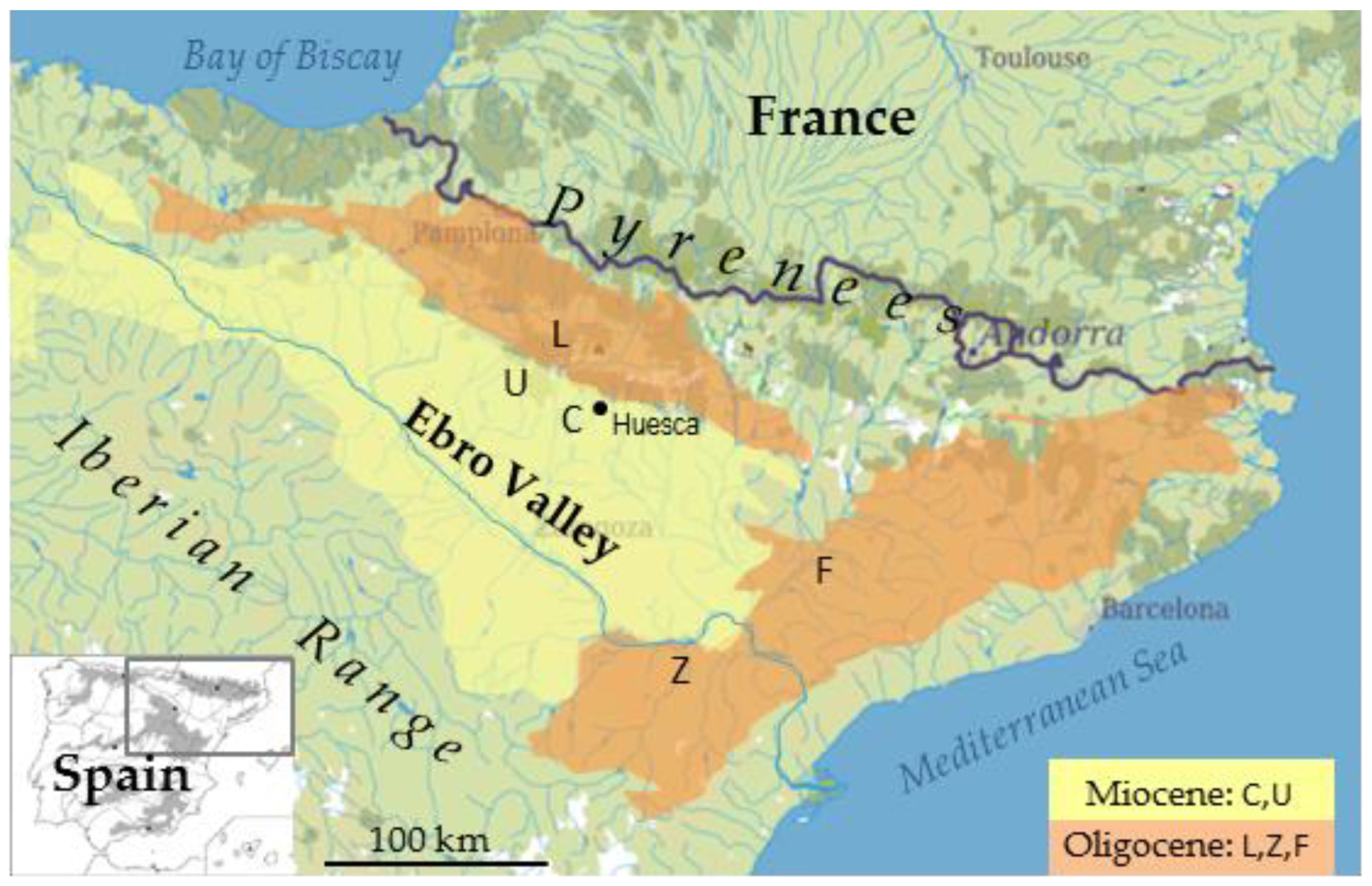
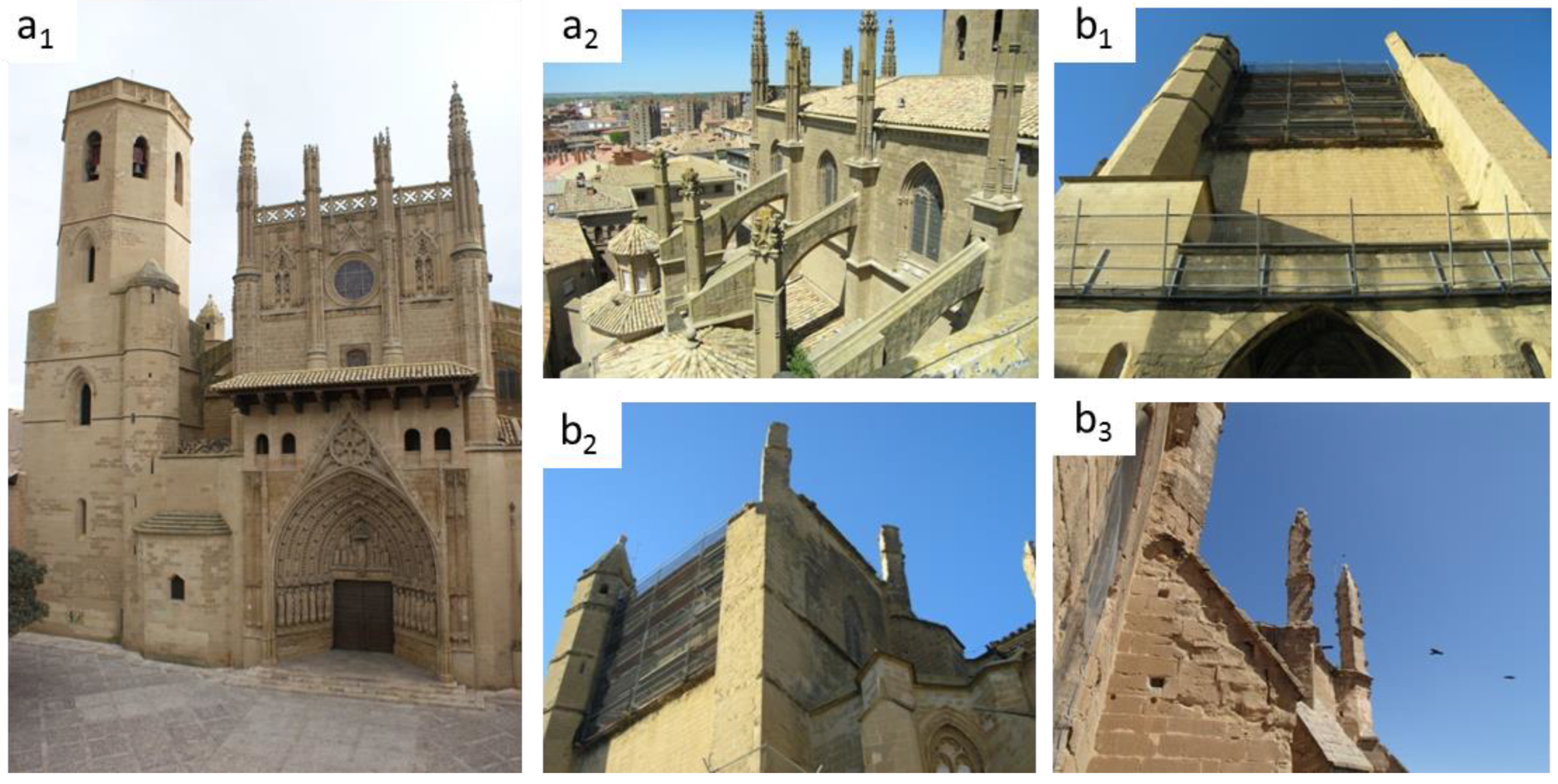
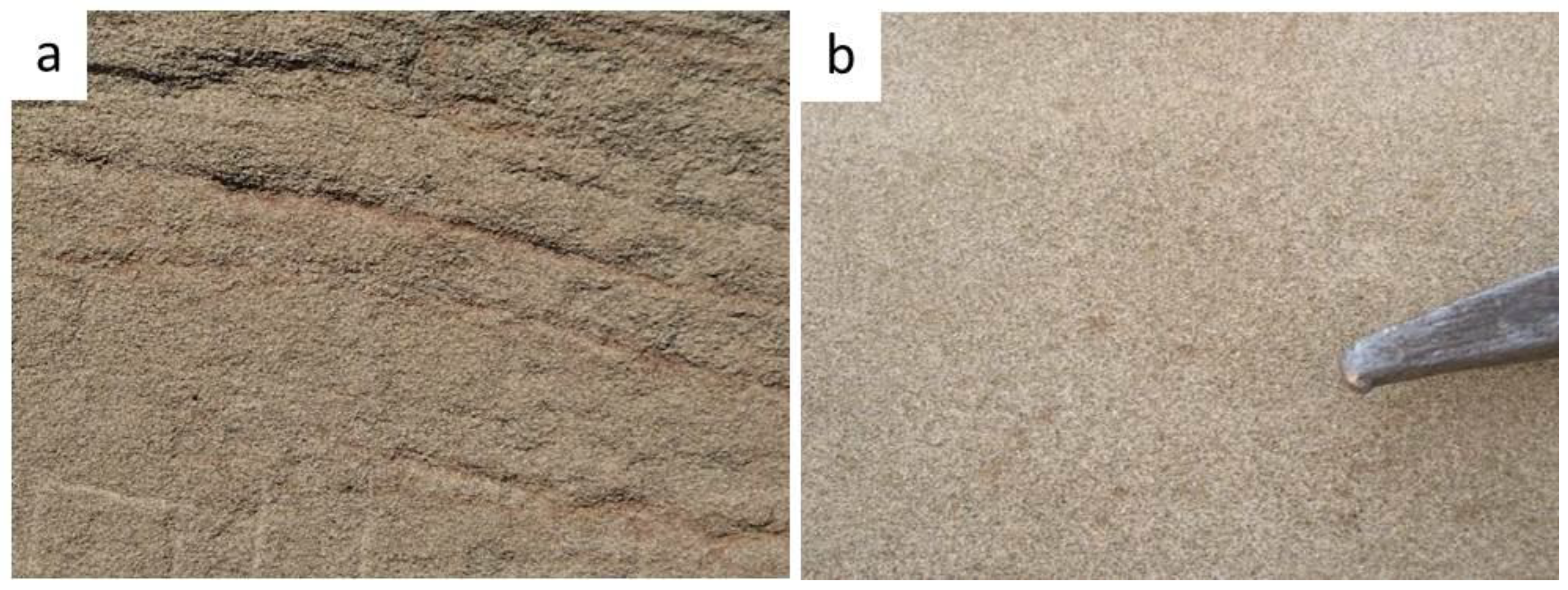
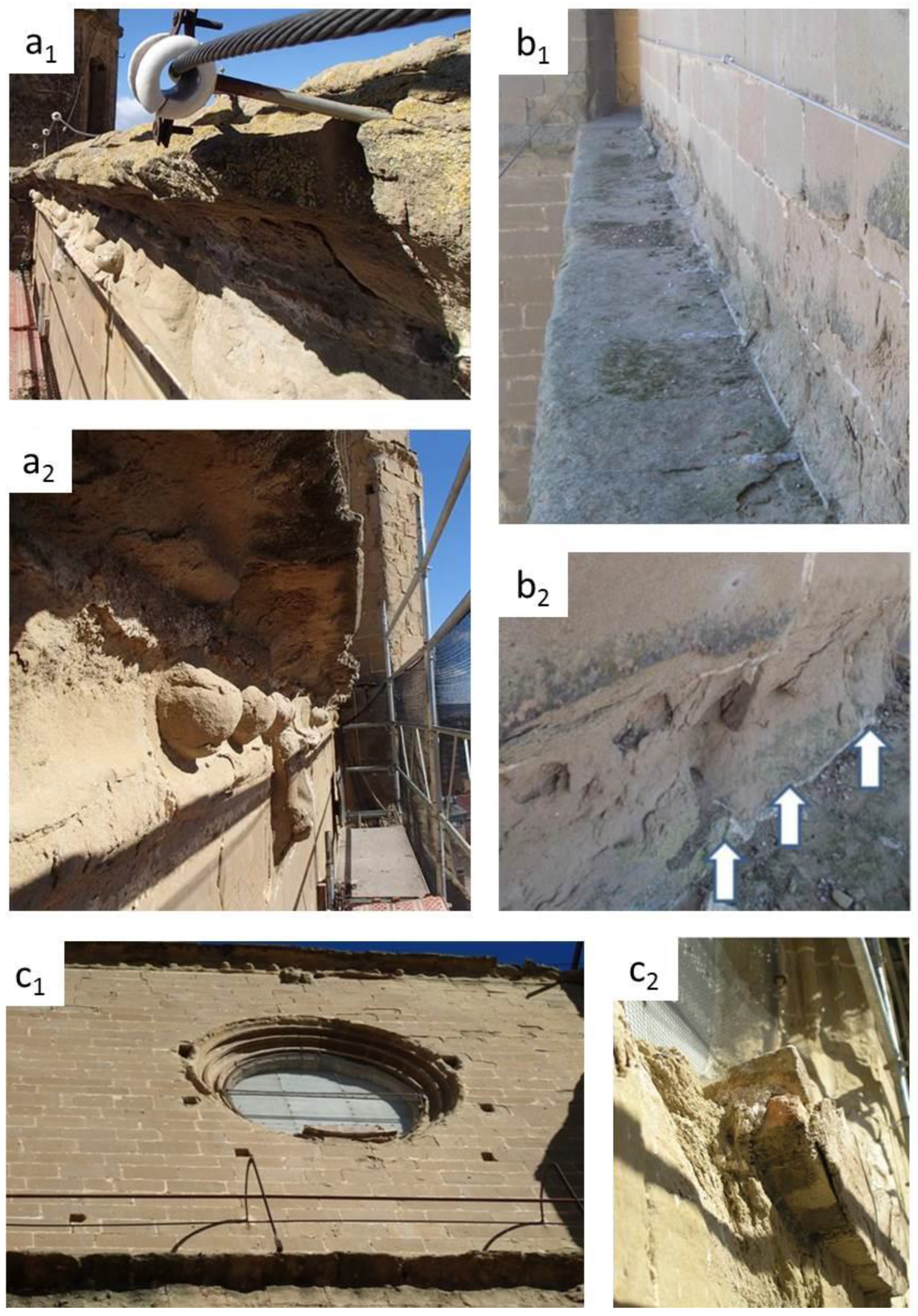
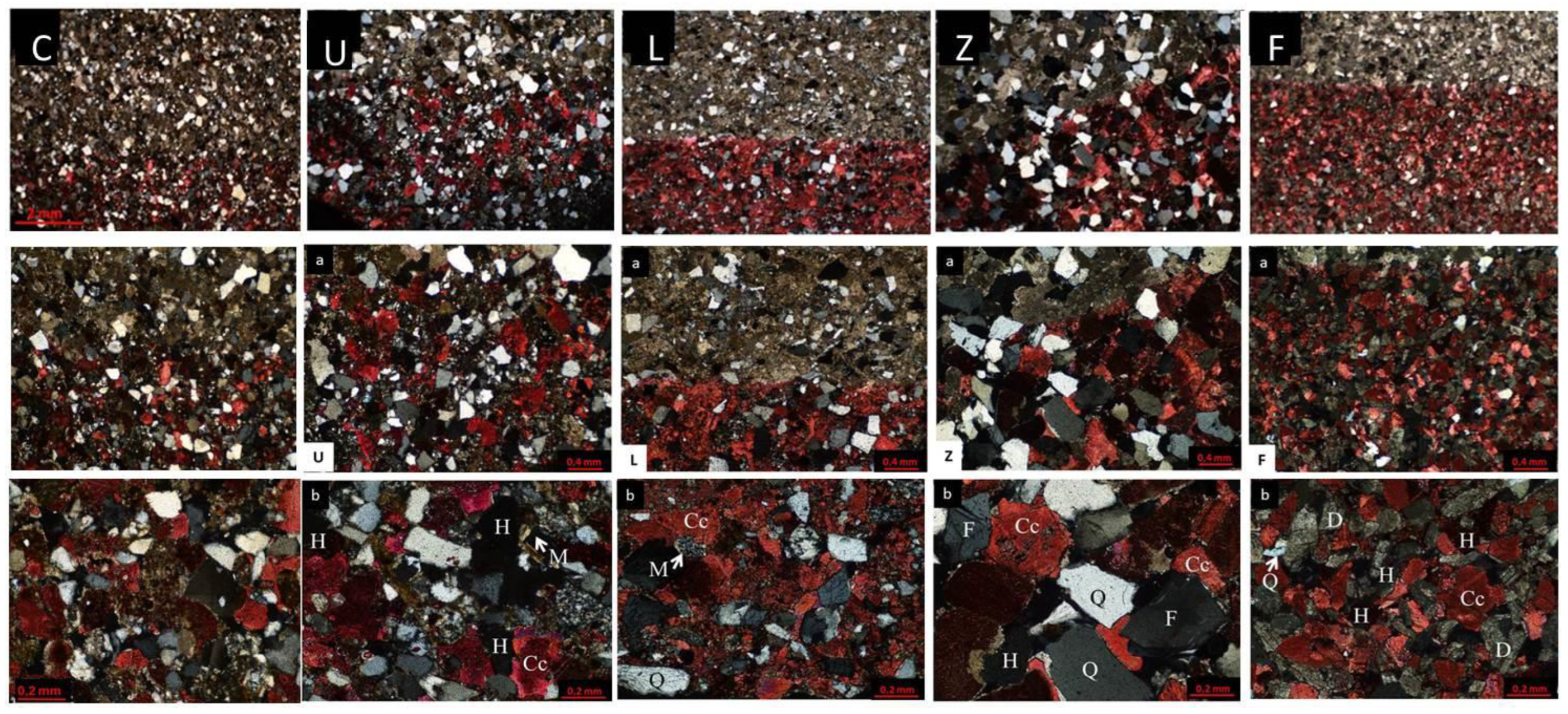

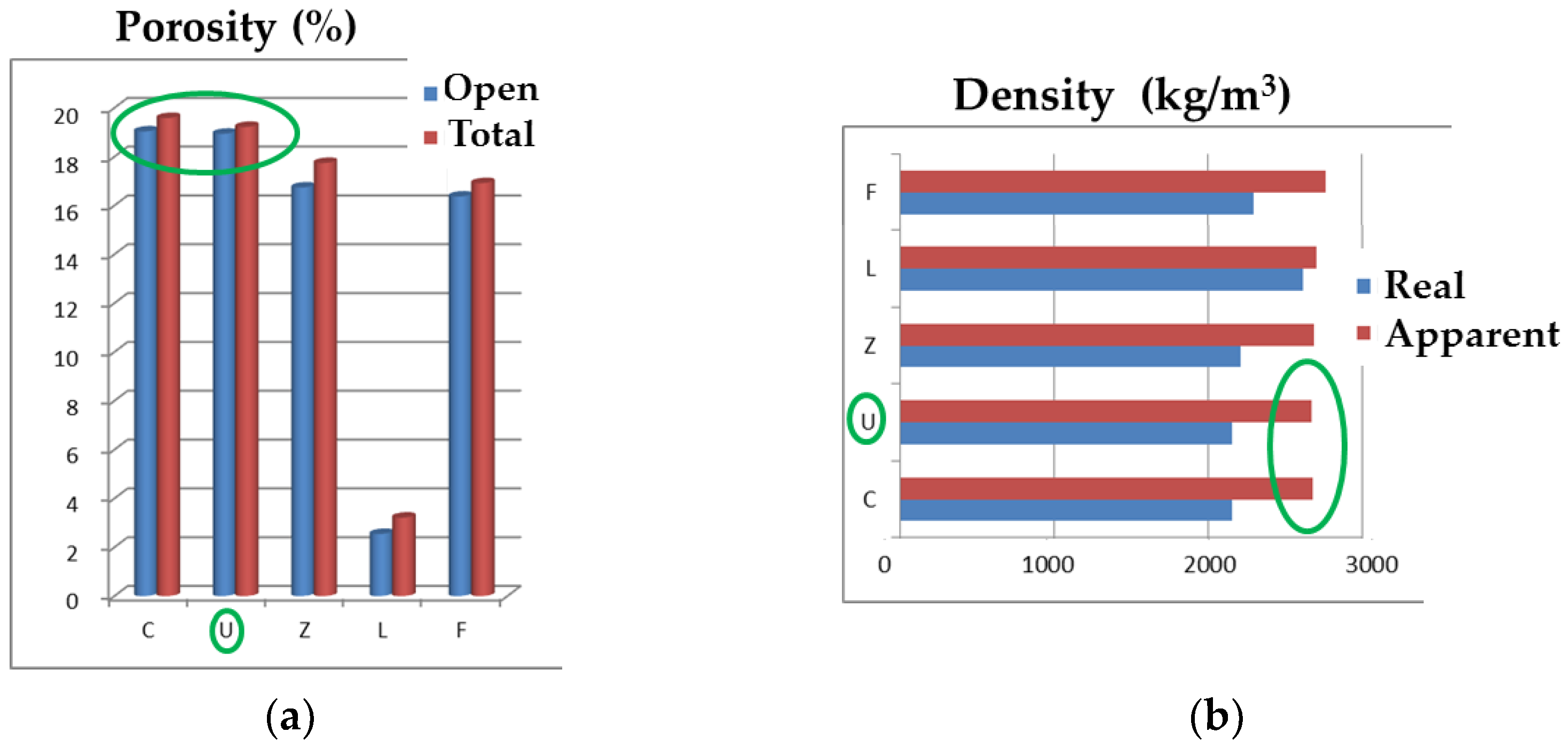
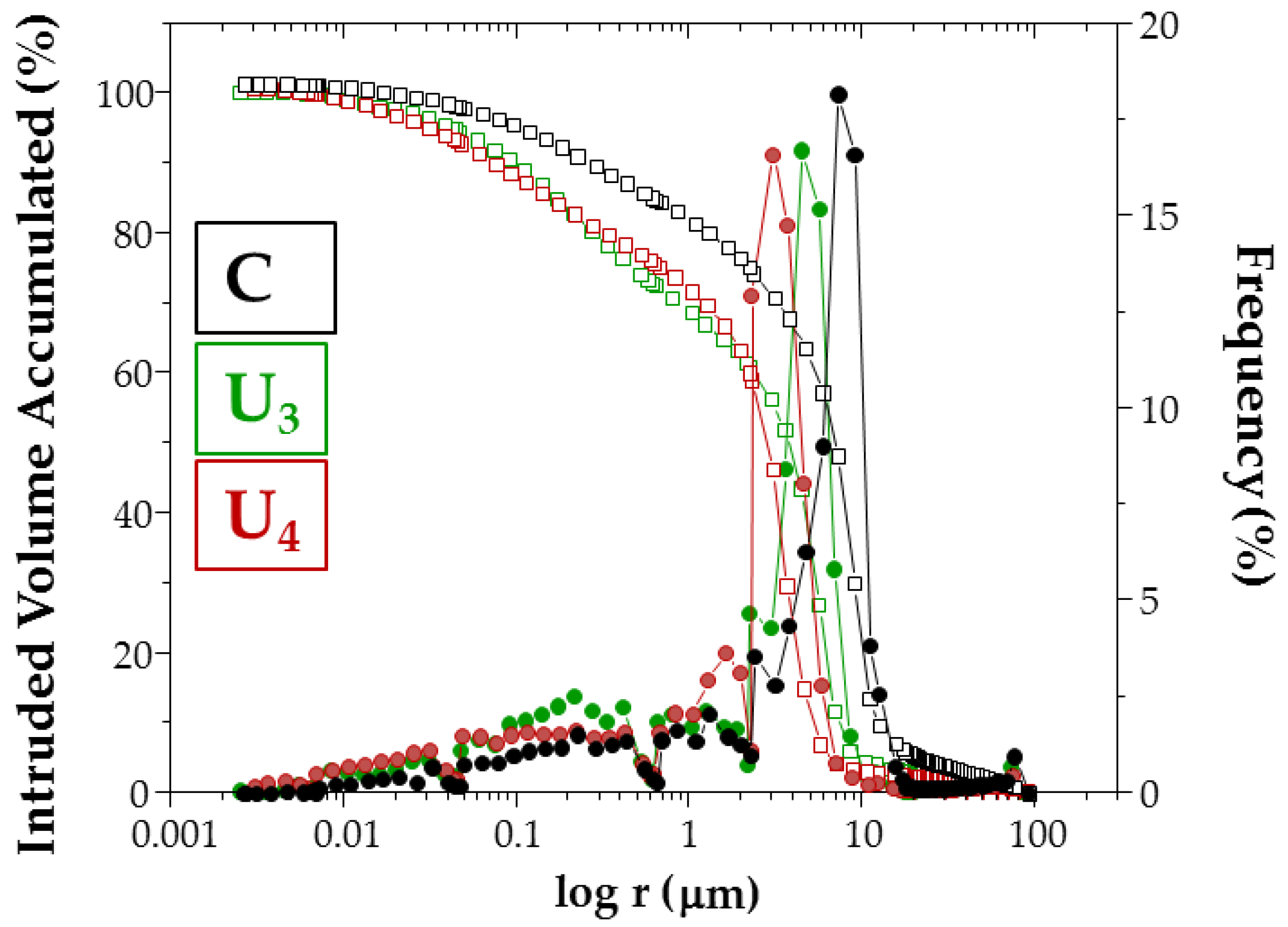
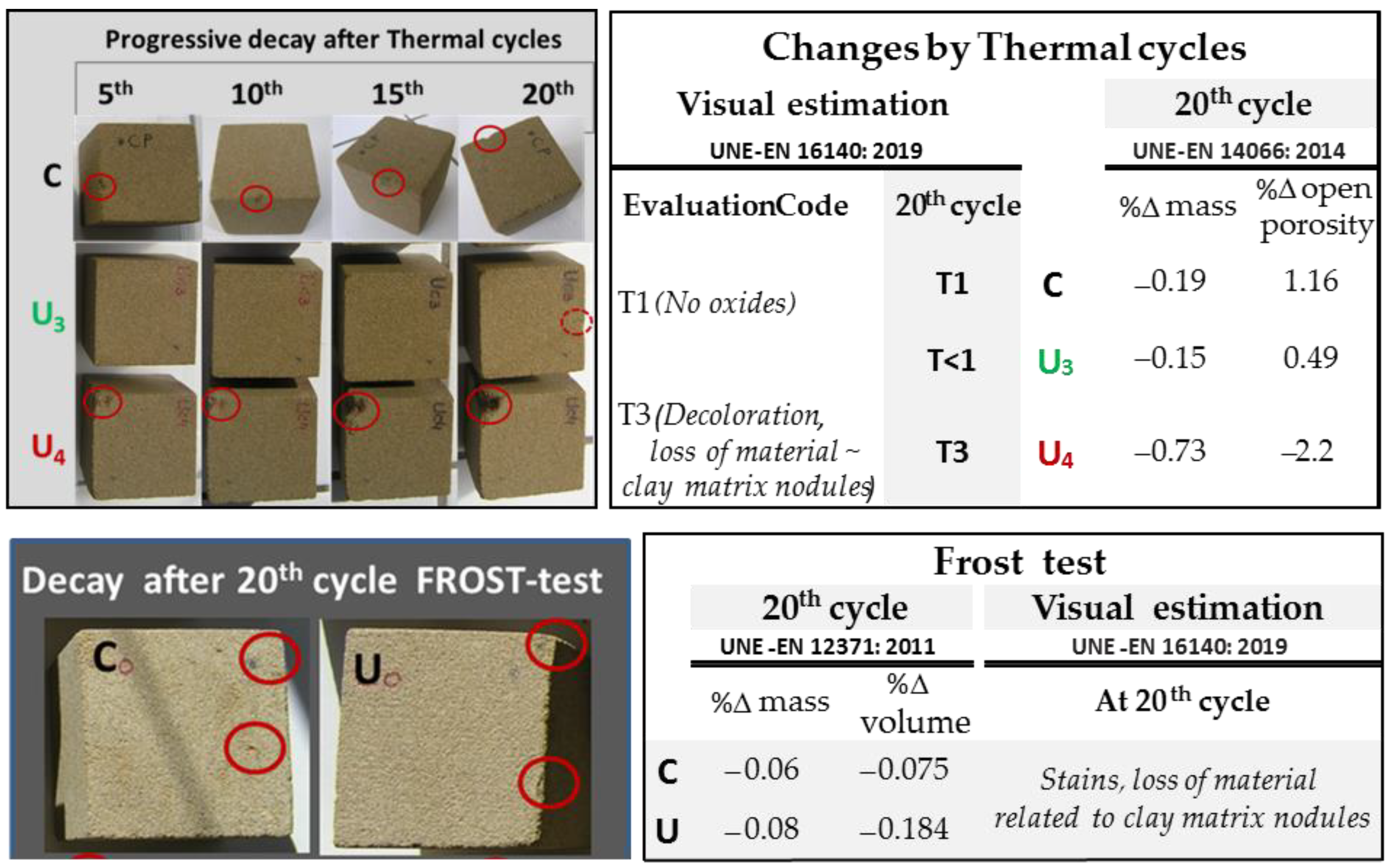
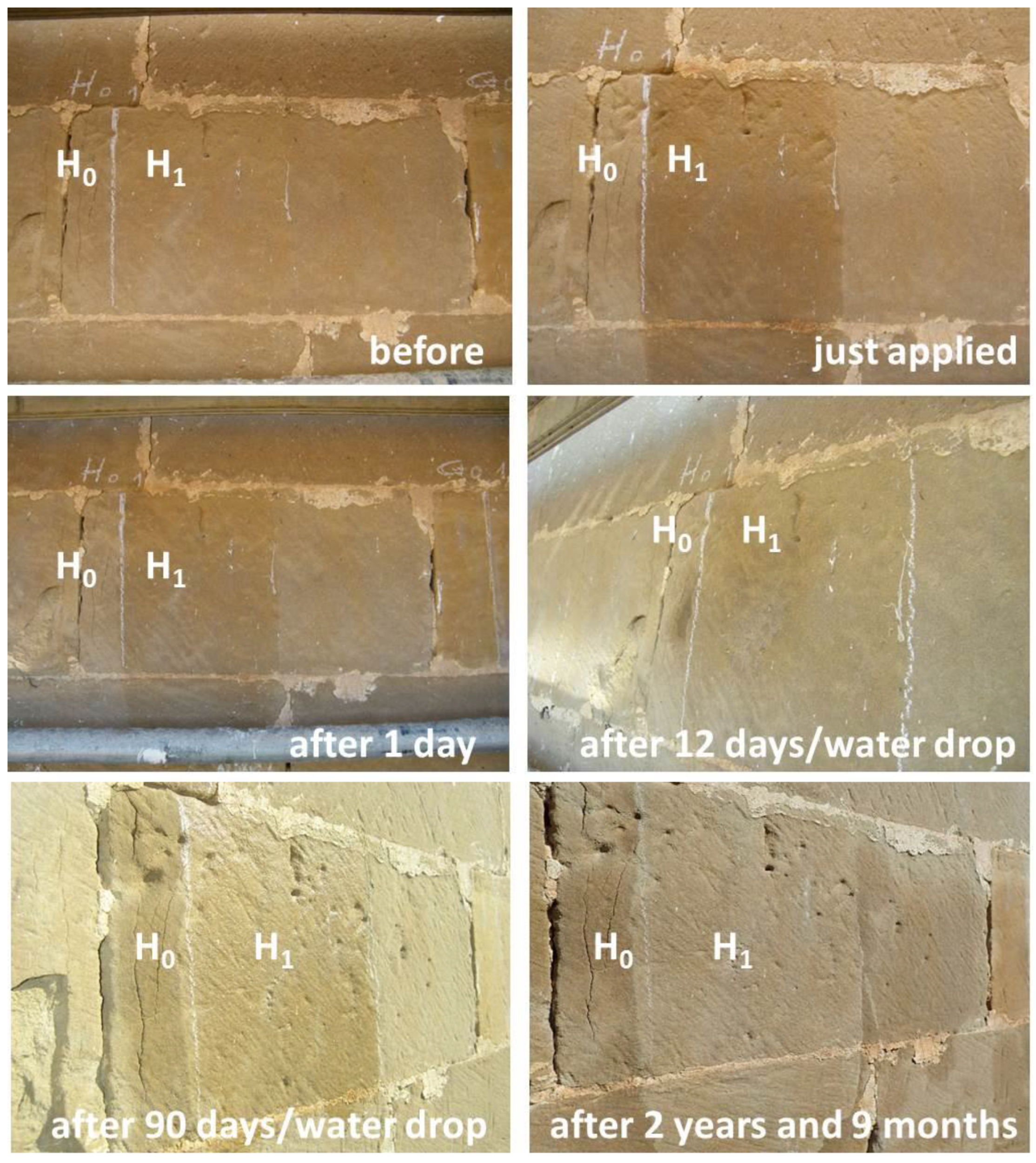
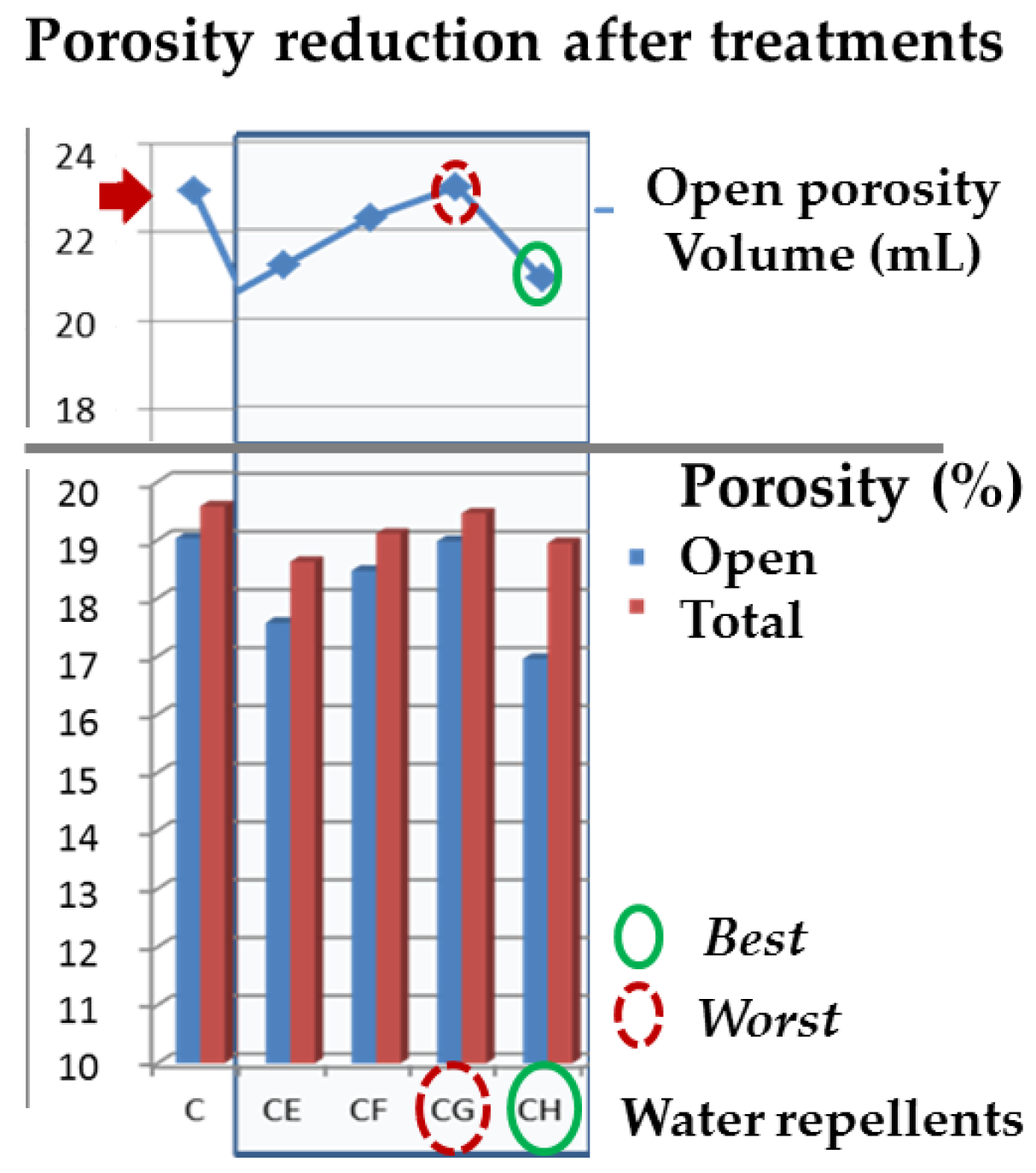
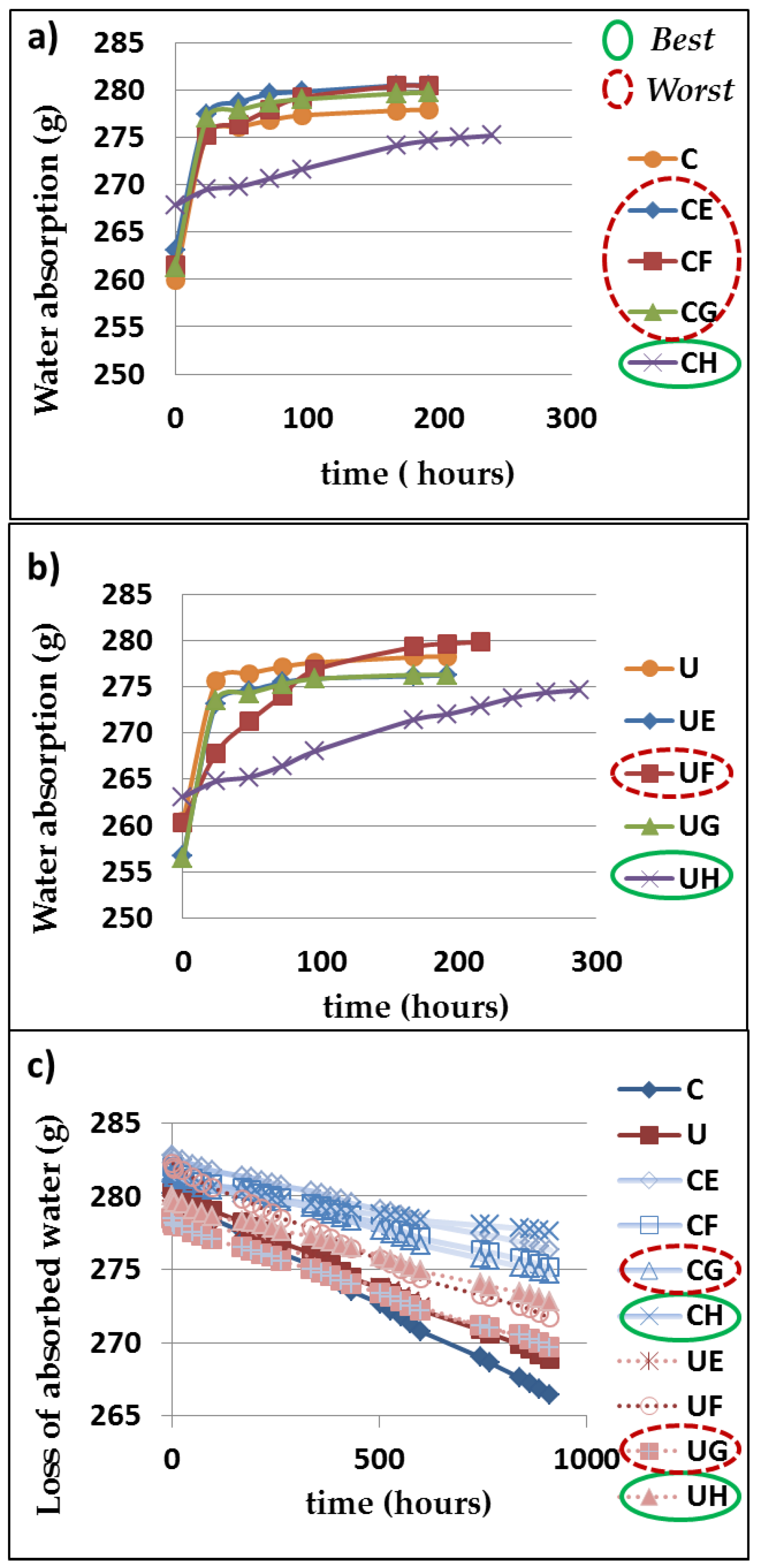
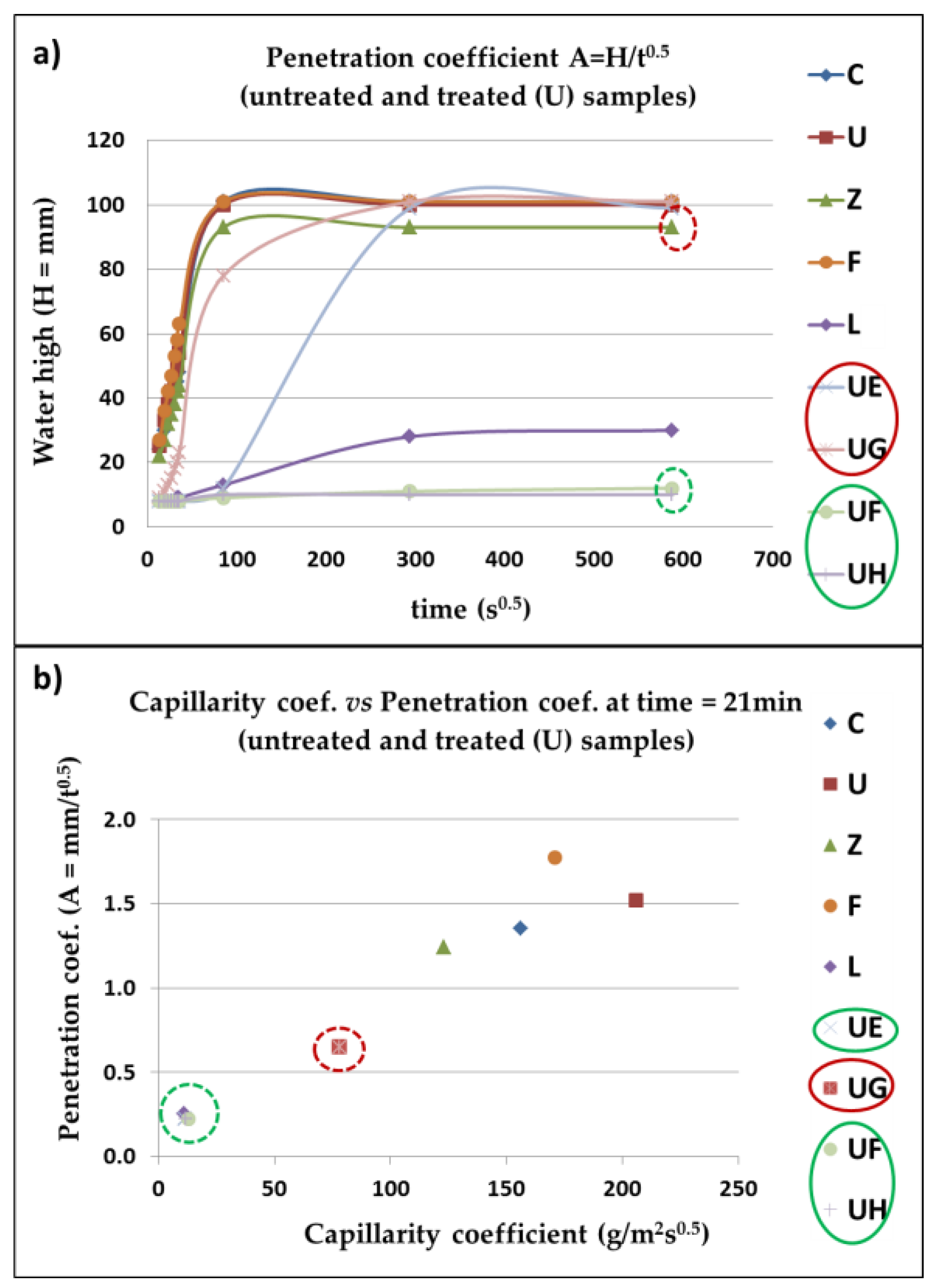
| Sandstone Variety | Cathedral C | Uncastillo U | Alastuey L | Alcañiz Z | Floresta F | |
|---|---|---|---|---|---|---|
| Geological Formation | Sariñena | Uncastillo | Campodarbe | Mequinenza-Ballobar | Floresta | |
| Age | Lower Miocene | Upper Eocene to Lower Oligocene | Oligocene | |||
| Colour | Munsell | 2Y 6/3 | 2Y 6/3 | 1Y 6/1 | 1Y 7/3 | 1Y 7/2 |
| L* (D65) | 62.5 | 63 | 64.1 | 68.9 | 75 | |
| a* (D65) | 3.8 | 4.1 | 2.5 | 4.0 | 2.1 | |
| b* (D65) | 17.1 | 16.1 | 9.0 | 17.0 | 12.4 | |
| ΔE*ab | 1.15 | 8.35 | 6.40 | 13.46 | ||
| Carbonate (LOI) CO2 % | 15.3 | 19.1 | 24.8 | 31.01 | 41.1 | |
| Calcite/dolomite | 100/0 | 100/0 | 95/5 | 100/0 | 70/30 | |
| Terrigenous % | 60–75 | 60–75 | 70–75 | 60–65 | 50–55 | |
| Carbonate fragments | 40–55 | 40–55 | 55–60 | 30–35 | 45–50 | |
| Siliciclastic (Quartz, Feldspars) | 15–18 | 15–20 | 10 | 30 | <5 | |
| Micas/marls | 2–5 | <5 | ||||
| Matrix % (Clays-illite, FeOx) | 8–12 | <10 | <5 | <5 | <5 | |
| Carbonate cement % (Sparite) | 5–14 | 10 | 20 | 20 | 30 | |
| Interparticle porosity % | 15–20 | 15–18 | <3 | 15–18 | 12–15 | |
| Granulometry | Φ media (mm) | <0.5 | 0.2 | 0.5 | <0.2 | |
| Sand (particle) | Fine-medium | Fine | Medium | Very fine | ||
| App. Den. (Kg/m3) | Real Den. (Kg/m3) | Open Por. (%) | Total Por. (%) | Op/tot (%) | VOp Por. (mL) | VAppPor. (mL) | Sat. Index (%); Days | Ret. Des. 912 h (%) | Cap. Coeff. at 21 min (g/m2 s0.5) | Pen. Coeff. (mm/s0.5) | |
|---|---|---|---|---|---|---|---|---|---|---|---|
| C | 2158.3 | 2683.8 | 19.0 | 19.6 | 97.2 | 22.9 | 120.5 | 6.9; 6 | 31.9 | 156.0 | 1.35 |
| U | 2158.4 | 2671.8 | 18.9 | 19.2 | 98.5 | 22.9 | 120.7 | 6.8; 6 | 41.6 | 206.0 | 1.52 |
| L | 2617.5 | 2704.3 | 2.5 | 3.2 | 79.2 | 3.2 | 126.2 | 5.5; 6 | 74.3 | 8.0 | 0.54 |
| Z | 2212.1 | 2689.1 | 16.7 | 17.7 | 94.3 | 20.0 | 119.5 | 1.0; 3 | 24.0 | 123.0 | 1.24 |
| F | 2301.3 | 2769.8 | 16.4 | 16.9 | 96.7 | 20.0 | 122.1 | 5.7; 6 | 61.1 | 171.0 | 1.77 |
| C + E | 2183.5 | 2683.8 | 17.6 | 18.7 | 94.4 | 21.2 | 120.5 | 6.6; 6 | 67.3 | - | - |
| C + F | 2170.4 | 2683.8 | 18.5 | 19.1 | 96.6 | 22.3 | 120.5 | 7.2; 6 | 66.5 | - | - |
| C + G | 2161.1 | 2683.8 | 19.0 | 19.5 | 97.5 | 23.0 | 120.9 | 7.1; 6 | 65.8 | - | - |
| C + H | 2174.9 | 2683.8 | 16.5 | 19.0 | 89.5 | 20.9 | 123.2 | 2.8; 7 | 70.5 | - | - |
| U + E | 2144.1 | 2671.9 | 18.6 | 19.8 | 94.2 | 22.3 | 119.7 | 7.6; 6 | 57.0 | 11.0 | 0.23 |
| U + F | 2131.6 | 2671.9 | 19.0 | 20.2 | 93.7 | 23.2 | 122.1 | 7.5; 6 | 51.7 | 13.0 | 0.23 |
| U + G | 2131.8 | 2671.9 | 20.2 | 20.2 | 99.7 | 24.2 | 120.3 | 7.8; 6 | 60.0 | 78.0 | 0.65 |
| U + H | 2154.8 | 2671.9 | 17.7 | 19.4 | 91.3 | 21.6 | 122.1 | 4.4; 10 | 57.5 | 12.0 | 0.23 |
| Intrusion Data Summary | C | U3 | U4 | |
|---|---|---|---|---|
| Sample Weight | g | 2.3045 | 2.1451 | 2.5812 |
| Total Intrusion Volume | mL/g | 0.1008 | 0.1055 | 0.0840 |
| Total Pore Area | m²/g | 0.596 | 1.074 | 1.210 |
| Median Pore Radius (Volume) | µm | 6.6974 | 3.8124 | 2.7677 |
| Median Pore Radius (Area) | µm | 0.0246 | 0.0223 | 0.0138 |
| Average Pore Radius (2 V/A) | µm | 0.3386 | 0.1965 | 0.1389 |
| Bulk Density at 0.0071 MPa | g/mL | 2.0843 | 2.1014 | 2.1645 |
| Apparent (skeletal) Density | g/mL | 2.6389 | 2.7003 | 2.6458 |
| Porosity | % | 21.0173 | 22.1782 | 18.1887 |
| Specimen | L* (D65) | a* (D65) | b* (D65) | MUNSELL |
|---|---|---|---|---|
| C | 62.4 | 4.46 | 18.51 | 1.3Y 6.1/2.8 |
| C + (E) | 60.75 | 4.65 | 19.06 | 1.5Y 6.0/3.0 |
| (E) Change ΔE*ab | 1.74 | (0.2Y −0.1/0.2) | ||
| C | 63.35 | 3.91 | 17.89 | 1.6Y 6.2/2.7 |
| C + (F) | 56.75 | 6.26 | 23.8 | 1.3Y 5.6/3.7 |
| (F) Change ΔE*ab | 9.16 | (−0.3Y −0.6/1.0) | ||
| C | 61.31 | 4.32 | 17.24 | 1.2Y 6.0/2.6 |
| C + (G) | 64.05 | 4.19 | 19.02 | 1.7Y 6.1/2.9 |
| (G) Change ΔE*ab | 3.27 | (0.5Y 0.1/0.3) | ||
| C | 62.89 | 3.47 | 16.78 | 1.8Y 6.2/2.5 |
| C + (H) | 61.02 | 3.93 | 18.11 | 1.7Y 6.0/2.7 |
| (H) Change ΔE*ab | 2.34 | (−0.1Y −0.2/0.2) | ||
Disclaimer/Publisher’s Note: The statements, opinions and data contained in all publications are solely those of the individual author(s) and contributor(s) and not of MDPI and/or the editor(s). MDPI and/or the editor(s) disclaim responsibility for any injury to people or property resulting from any ideas, methods, instructions or products referred to in the content. |
© 2024 by the authors. Licensee MDPI, Basel, Switzerland. This article is an open access article distributed under the terms and conditions of the Creative Commons Attribution (CC BY) license (https://creativecommons.org/licenses/by/4.0/).
Share and Cite
Lapuente Mercadal, M.P.; Cuchí Oterino, J.A.; Auqué Sanz, L.F. Compatibility Assessment in the Replacement of Damaged Sandstone Used in the Cathedral of Huesca (Spain). Heritage 2024, 7, 896-912. https://doi.org/10.3390/heritage7020043
Lapuente Mercadal MP, Cuchí Oterino JA, Auqué Sanz LF. Compatibility Assessment in the Replacement of Damaged Sandstone Used in the Cathedral of Huesca (Spain). Heritage. 2024; 7(2):896-912. https://doi.org/10.3390/heritage7020043
Chicago/Turabian StyleLapuente Mercadal, María Pilar, José Antonio Cuchí Oterino, and Luis Francisco Auqué Sanz. 2024. "Compatibility Assessment in the Replacement of Damaged Sandstone Used in the Cathedral of Huesca (Spain)" Heritage 7, no. 2: 896-912. https://doi.org/10.3390/heritage7020043
APA StyleLapuente Mercadal, M. P., Cuchí Oterino, J. A., & Auqué Sanz, L. F. (2024). Compatibility Assessment in the Replacement of Damaged Sandstone Used in the Cathedral of Huesca (Spain). Heritage, 7(2), 896-912. https://doi.org/10.3390/heritage7020043






